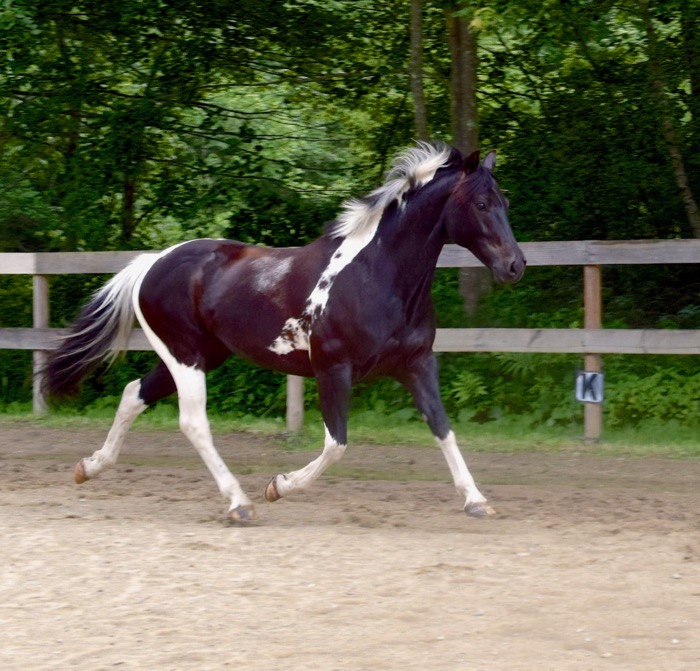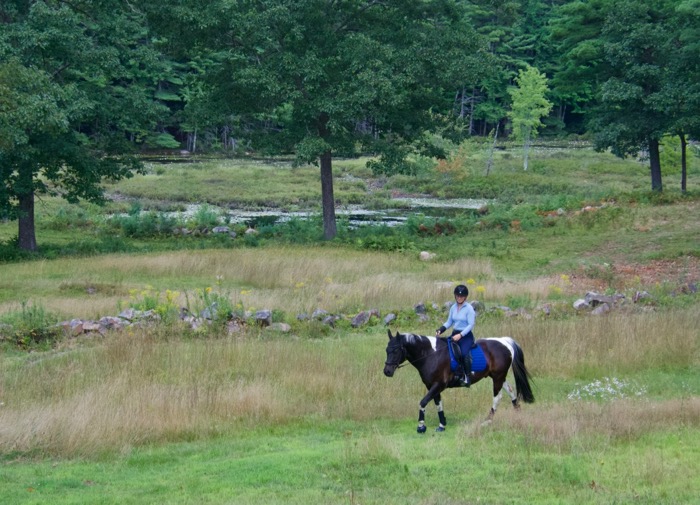Tonka was almost eight years old when I purchased him, and he was barefoot. He’d always been barefoot. His hoof walls were strong with nary a crack or chip. They were beautifully shaped and all four matched. No weird angles. All the same size. Those gorgeous hooves were a selling point. I planned on keeping him barefoot.

I did notice, when I tried him, that he was super cautious walking across gravel. But he vetted out sound.
His previous home was a grass field and the ring was high-tech surface perfection. His new home was either muddy or hard as concrete, the riding ring and trails were rocky. Classic New England. Over the next six months, Tonka got ouchier and ouchier. I worked with my excellent farrier, who was as committed as I was to keeping him barefoot. The hoof is like a very tough fingernail, but it’s not solid. It encases blood and bone and nerves. Tonka’s soles were thin, and instead of toughening up, Tonka was getting bruised.
Hoof boots are an option for some horses with thin soles. For example, if the only time your horse is ouchy is when riding on a rocky trail, then you can put them on before you head out. But Tonka was sore everywhere.
Tonka got front shoes. Immediately, he let me know that he felt better.
Look, I can float!

Tonka now wears shoes on all four. He also has pads on front, and under the pads are the equivalent of Dr. Scholl’s insoles.

The shoes keep him comfortable when he walks out to his paddock on this:

It’s said that in New England, our primary crop is rocks. It doesn’t matter how often you pick them out of the paddock, more will sprout up.

Some horses have hooves that toughen up in these conditions. Not Tonka.
Shoes add a level of complexity and worry to horse care. You have to check them daily. The horse can lose a shoe. You never know what will get jammed in.

You need a farrier who is very, very good. The choice of shoe, the trim, the angle, will affect how your horse’s hooves strike the ground and how your horse moves. It takes my farrier, Rebecca, well over an hour to shoe Tonka. She shapes each shoe.

This is her apprentice. There’s smoke and banging and yet Tonka likes the process!

Before each shoeing, Rebecca and I discuss how Tonka is going. To ease his SI joint weakness, she adjusted how she trimmed his hind toes. The next ride, I felt more spring from behind. A good shoeing job can ease the pain of navicular disease and other ailments. But it can go the other way. A bad shoeing job can create all sorts of problems. Just one more thing for us horse owners to obsess about.
Would I prefer not to spend $260 every five weeks? Would I prefer to let Tonka’s feet contact the ground as nature intended? Of course. But, as always, I listen to Tonka.



Love all pictures of Tonka, but the one with his nose>>>AWESOME! and comforting in some way.
The post about Tonka’s Shoes is wonderful. I love the photos Steve Golson captures.
Rebecca is the first woman farrier I’ve seen at work in all my years of knowing horses. Her work is so carefully done, truly designed to fit each and every hoof for that particular much loved horse. And now an apprentice (male) joining the work. Neat!
Taking care of my horses hooves is very important to me. Here in the Missouri Ozarks the ground is extremely rocky also. Therefore my horses have to wear shoes all year. I am fortunate to have a very good farrier. You know the old saying, “no hoof, no horse”.
The horses I have now have tough soles and good hooves, but I had one horse that was ouchy on rocky ground, I treated her soles with Venice Turpentine and got good results.
My decision to move to this area of Maine only was finalized when I knew I’d have a good farrier!